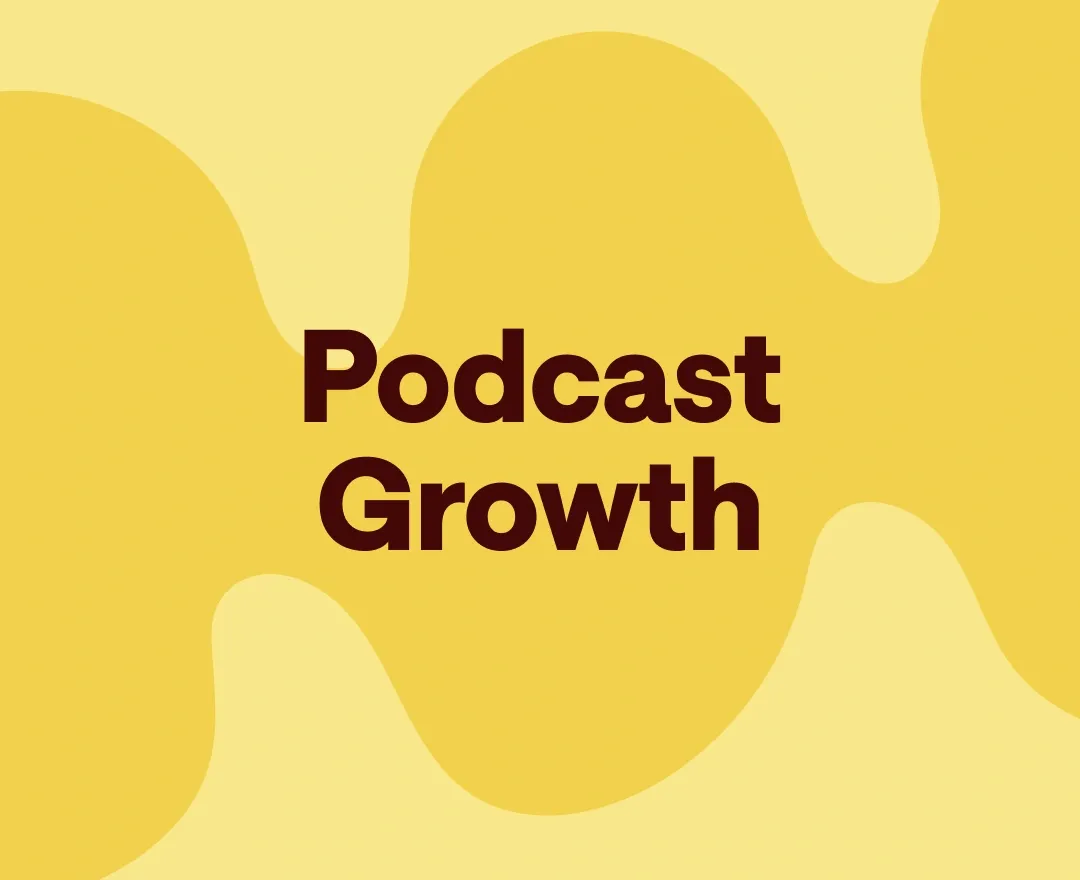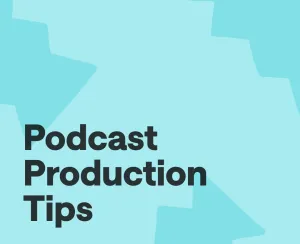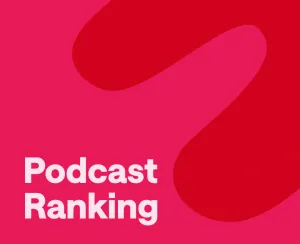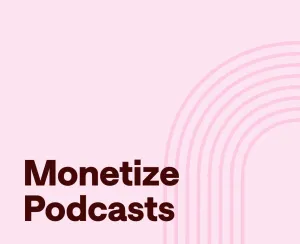You launched your podcast. You did the work. Maybe you’ve recorded a few episodes, shared them on social, and watched the download numbers… do almost nothing.
It’s frustrating. You know your content has value, but reaching the right people feels impossible. Growing a podcast audience can feel like shouting into the void.
The good news? You’re not doing anything wrong. Discoverability is hard in 2025. But the right strategy (combined with consistency) can help your show reach more of the listeners who are actually looking for content like yours.
In this guide, you’ll learn exactly how to grow your podcast audience organically. No paid ads, no shortcuts, no weird tricks. Just real tactics that help listeners find you, connect with you, and come back for more.
Table of Contents
– Is Podcasting Still Worth It in 2025?
– Are You Ready to Grow Your Podcast? (Checklist)
– 14 Tips to Grow Your Podcast in 2025
1) Define Your Niche and Target Audience
2) Create Podcast Content People Want to Come Back To
3) Make Podcast Titles and Descriptions Work For You
4) Promote your Podcast on Social Media
5) Collaborate with Other Podcasters
6) Repurpose Your Podcast Into Other Content
7) Use Smart CTAs in Your Episodes
8) Encourage Listener Interaction
9) Optimize your Podcast for SEO
10) Treat Email Marketing as an Extra Touchpoint
11) Get Listed on Every Podcast Directory That Matters
12) Run Promotions and Giveaways
13) Create an Engaging Podcast Trailer
14) Add Video Content to Your Podcast
– How to Create Podcast Content with Podcastle
Is Podcasting Still Worth It in 2025?
The short answer is yes, there's still room for podcasters (and growth). But it’s a different game than it was five years ago.
There are over 6.5 million podcasts in existence today, but less than 500,000 are active. That means most people start… then stop. Usually within 10 episodes.
At the same time, the number of podcast listeners keeps growing. In the U.S. alone, more than 100 million people listen to podcasts weekly. Globally, that number is over 584 million, and it’s expected to keep climbing well into 2026.
This actually bodes well. You might look at the numbers and think that you'll be sitting in an oversaturated market, but the number of listeners is exploding too. All you need is to be found, and with how many people are looking for podcasts, you're bound to be discovered, and that's the first step to growth.
That means starting a show in 2025 is still a smart move. But if you want to grow, you need to show up where your audience already hangs out. And you need to give them a reason to hit follow.
Before we get to the growth tactics, let’s check if you’re in the right position to focus on growth yet.
Are You Ready to Grow Your Podcast? (Checklist)
Before you dive into growth strategies for your podcast, take a look at where you're currently at. For example, you'll know you're ready to focus on growth when:
- You’ve launched at least 3 full episodes
- You know your niche and who you’re speaking to
- You’ve picked a regular release schedule (and stuck to it)
- You’re willing to talk about your podcast more than once a week
- You’ve got a basic system for recording and publishing
- You’re open to trying new things and staying consistent
If you’re still working on a few of these, that’s totally fine. Bookmark this guide and come back once your show has a little momentum. If you’re ready to grow, keep reading.
14 Tips to Grow Your Podcast in 2025
1) Define Your Niche and Target Audience
If you’re trying to grow, clarity beats creativity every time. And you don’t need to be wildly original either, you just need to be specific. When a potential listener sees your show, they should immediately know what it’s about and whether it’s for them.
That starts with choosing a niche and knowing your audience.
Your niche is the corner of the podcast world you’re going to live in. It’s not just “business” or “sports.” It’s more like “bootstrapping your first online business” or “underrated athletes who changed the game.” The tighter your focus, the easier it’ll be for the right people to find and stick with you.
Your target audience is who you’re trying to reach. These aren’t generic demographics like “women aged 25–34.” Think in terms of mindset and motivation:
- What do they care about?
- What kind of language do they use?
- What problems are they dealing with?
- What are they hoping your podcast helps them understand or solve?
When you know the answers to those questions, you can start shaping your episodes, titles, and promos to speak directly to that person.
And when someone hears your show and feels like it was made for them, they stick around.
Useful Audience Analysis Tools
- Google Trends: Explore trending topics and search queries related to your potential podcast niche. This can help you gauge the current popularity and interest levels in specific subjects.
- Podchaser: Podchaser provides information about podcasts, including audience reviews and ratings. Analyze similar podcasts in your niche to understand their audience's preferences and feedback.
2) Create Podcast Content People Want to Come Back To
There’s no hack for growth if the content isn’t landing. You don’t need the world’s best mic or a viral moment. You need episodes people enjoy and remember, and a rhythm that keeps them coming back for more.
Start with the basics: are you delivering something that’s worth a listener’s time? Not just information, but perspective. Not just conversation, but clarity. People listen to podcasts because they want to learn, laugh, or feel understood. Your job is to give them that experience consistently.
That doesn’t mean every episode has to be perfect. But it does mean you should:
- Open strong and get to the point fast
- Avoid rambling or filler just to hit a certain length
- Structure episodes so they’re easy to follow (intro, core, outro)
- Speak naturally. Don’t write a script like it’s a press release
- End with a reason for them to come back next week
Once you find a flow that works, stick to it. A regular release schedule builds trust. Whether that’s weekly, bi-weekly, or monthly, consistency helps your podcast become a habit for your listeners. Miss too many episodes without notice and people stop checking in.
The creators who grow their audience aren’t always the ones with the best ideas. They’re the ones who keep showing up, who refine each episode just a little, and who treat their show like something worth investing in.
Useful Content Creation Tools
- Trello: Use Trello as a content calendar. Assign due dates to episodes, and use labels to categorize content based on themes or series. This visual approach helps you maintain a consistent posting schedule.
- Chartable: Chartable provides detailed analytics about your podcast audience. You can use this data to understand listener demographics, geographic locations, and which episodes are performing well. Tailor your content based on these insights.
3) Make Podcast Titles and Descriptions Work For You
If your episode title doesn’t grab someone in five seconds, they’re scrolling past it. That might sound harsh, but it’s true. On platforms like Spotify and Apple Podcasts, your title and description are the only things someone sees before deciding whether to listen.
That means they need to do a lot of work. They need to:
- Spark curiosity
- Clearly explain the value of the episode
- Use words your audience actually types into search bars
Forget trying to be overly clever. Focus on being useful and clear. Say what the episode is about in simple, direct language. If there’s a takeaway, promise it up front. If there’s a guest, highlight what makes them worth hearing from. A good title isn’t vague. It’s specific and easy to understand.
Descriptions matter too. They don’t need to be long, but they should help both listeners and search engines understand what’s inside. Think of your description like a preview: what will they learn, what topics are covered, and why should they care?
It’s also smart to include keywords your ideal listener would actually search for. Not in a spammy way, just naturally. You want your episodes to show up when someone searches for “how to start a solo podcast” or “interview tips for podcasters.”
Useful Keyword Research Tools
- Ubersuggest: Ubersuggest provides keyword suggestions and analyzes the search volume, competition, and trends for specific keywords. Use this information to choose keywords that align with your podcast content.
- Google Keyword Planner: Conduct keyword research to identify relevant and popular keywords related to your podcast niche. This tool helps you understand what terms your potential audience is searching for.
4) Promote your Podcast on Social Media
Creating the episode is one thing. Getting people to hear it is something else entirely.
Social media is one of the easiest ways to promote your podcast, but also one of the easiest to mess up. Too many creators post once, say “new episode out now,” and then wonder why nothing happens.
Here’s the truth: if you want your content to reach new listeners, you have to share more than just a link. And you have to do it more than once.
That doesn’t mean spamming. It means repackaging your episode into different kinds of posts:
- A short video clip with captions
- A quote that hits hard
- A story about why you made the episode (maybe with a poll!)
- A question pulled from the episode topic to spark discussion
You’re pulling people into the world of your podcast, so give them a reason to. Or multiple reasons. The more, the better.
Choose 1–2 platforms where your audience actually hangs out. Don’t try to master everything. If your content is visual or conversational, Instagram, TikTok, or YouTube Shorts are solid bets. If your podcast is niche or industry-focused, LinkedIn or Twitter might work better.
And remember: consistency here matters just like it does in podcasting. Schedule your posts in advance so you don’t burn out. Engagement builds over time.
Useful Social Media Tools
- Hashtagify: A handy tool for discovering the best hashtags for your episode topics. You can check hashtag popularity, find related tags, and see what’s currently trending in your niche. Great for increasing reach without guessing what to tag.
- Buffer: Buffer makes it easy to schedule posts across Twitter, Instagram, LinkedIn, and Facebook. You can write and queue everything in one place, then check basic performance stats to see what’s getting the most clicks or engagement.
- Social Champ: Another all-in-one scheduler that works across platforms. It also lets you track brand mentions, pull in trending content ideas, and review performance—all from one dashboard. Great if you want a bit more than just scheduling tools.
- Hootsuite: A solid option if you’re juggling multiple accounts or collaborating with others. Hootsuite lets you schedule posts, monitor engagement, and respond to messages across several channels. It’s especially useful for podcasters growing a team or managing a show across multiple platforms.
5) Collaborate with Other Podcasters
One of the fastest ways to grow your audience is by showing up in front of someone else’s. That’s what makes collaboration so powerful: it puts you in front of people who already listen to podcasts, already trust the host, and are already interested in your niche.
But not all collabs are created equal. The best ones feel natural, mutual, and valuable for both audiences.
Here’s how to do it right:
- Be a guest on other shows. Don’t pitch yourself as “a podcaster looking for exposure.” Pitch a great idea or unique story that fits their audience.
- Bring guests onto your own show. Pick people who offer a fresh perspective or who are connected to the listeners you want to reach.
- Swap promos. Record a short trailer for each other’s podcast and run them at the end of your episodes. It’s simple, easy, and works when the audience overlap is right.
- Co-host a bonus episode or livestream. It doesn’t have to be complicated, just something that shows your audience you’re plugged into the space.
Good collaborations lead to more than just listeners. They lead to relationships, referrals, and long-term visibility. Start small, build genuine connections, and don’t treat every invite as a transaction.
Useful Collaboration Tools
- The Podcast Collaborative: This platform provides access to private host and guest directories, which can help you find and get found by hundreds of other members. They also organize virtual mixers to expand your business network and explore collaboration possibilities.
- MatchMaker.fm: Another great tool for podcasters looking to collaborate with others. It has features that allow you to filter potential guests by over 100 niches and add video pitches to your guest profile.
6) Repurpose Your Podcast Into Other Content
You don’t need to record more. You need to squeeze more value out of what you’ve already made.
Repurposing is how you turn one episode into five pieces of content, or more. It helps you show up consistently online without spending hours creating new stuff every time. And it makes your podcast easier to discover by people who don’t use podcast apps much.
Here’s how to get started:
- Turn your episode into a blog post. Summarize key takeaways or turn part of the conversation into an article.
- Cut out a great clip. Grab a short moment from the episode, add subtitles, and post it to Instagram, TikTok, YouTube Shorts, or LinkedIn.
- Quote yourself or your guest. Turn a strong line into a tweet or image post. You can even batch several at once and use them over time.
- Use the transcript. Pull quotes, captions, summaries, or newsletter blurbs straight from your own words.
- Create an audiogram. Use a short snippet with waveforms and cover art (it still works well in some spaces.)
Most people won’t see everything you post. That’s why it’s smart to present the same ideas in different ways. When you repurpose your episodes, you meet people where they are, whether that’s on social, search, or their inbox.
Useful Repurposing Tools
- Podcastle: You can instantly trim and resize content into short-form Reels, Shorts, or TikToks with our AI Video Editor, as well as transcribe any audio content which you can then repurpose into a blog.
- Repurpose.io: Automates your workflow by connecting platforms. For example, you can auto-publish podcast clips from Dropbox to TikTok, YouTube Shorts, or Reels.
7) Use Smart CTAs in Your Episodes
If you want your podcast to grow, you have to tell people how to support it through actionable CTAs. That means asking them, clearly and confidently, to follow, share, rate, or engage. The best time to do that? Right in the episode.
You don’t need to sound salesy. You just need to be intentional.
Instead of rattling off a list of vague asks like “rate, review, and subscribe,” give one clear call to action that makes sense for where the listener is. For example:
“If this episode helped you, send it to one friend who needs to hear it.”
“Follow the show so you don’t miss next week’s episode on [topic].”
“If you loved this content, leave a quick rating on Spotify to let others know”
If your show is longer, it’s okay to mention your CTA twice, once casually in the middle, and again at the end. Just make it part of the flow, not a chore.
And the most important part? Keep it consistent. If you ask the same thing every week, listeners start to remember. Some will even act on it after hearing it a few times.
Useful CTA Tools
- Chartable SmartLinks: Create a custom link to track which platforms your listeners are clicking from. Use this to measure what’s working when you say things like, “Click the link in the description.”
- Podcastle Chapters: Break your episode into sections and add brief CTA markers—like “How to support the show” or “Share this with a friend.” Helpful for driving action without interrupting the episode flow.
- Linktree or Beacons: Collect your email signup, voice submission form, and podcast subscription links in one clean page. Pin it everywhere. Use labels that match your episode prompts: “Tell your story,” “Send a voice message,” “Vote on the next topic.”
8) Encourage Listener Interaction
You’ll get replies when you give people something to respond to. Most podcasters ask, “Let me know what you think,” then wonder why nothing happens. There’s no hook in that.
Here’s how to fix it:
- Ask a question worth answering: Don’t end your episode with filler. Ask something tied to the topic, like “Would you have handled that differently?”, “Have you ever been in that situation?”, or “What’s the worst advice you’ve ever taken?”
- Set a deadline: Say, “Send your reply by Friday and I’ll read a few next week.” People respond faster when there’s a clear timeline.
- Make your link easy to find: Use a Linktree or bio tool and label it clearly, “Send me a voice message” or “Share your story.” Put the link in your show notes and your Instagram bio. If they have to look for it, they won’t.
- Start new episodes with listener replies: Even if you only have one. Even if it’s from your cousin trying to help. Highlight it. That moment tells your audience this show actually listens back.
- Run a regular shoutout: Make it a quick segment, like “DM of the week” or “Listener hot take.” Keep it under 30 seconds. It gives people a reason to chime in.
Useful Community Tools
- SpeakPipe: Create a custom link that lets listeners leave voice messages directly from their browser. No sign-in, no download. You can embed it on your website or drop the link in your show notes. Great for Q&As or episode intros.
- Typeform or Tally: Build clean, branded feedback forms. Ask listeners to share stories, submit questions, or vote on upcoming topics. Both are mobile-friendly and take two minutes to set up.
- Podpage: Generates a simple website for your podcast with no coding required. Includes a built-in contact form, listener reviews, and even a guest submission page if you want to crowdsource future episodes.
9) Optimize your Podcast for SEO
Podcast apps aren’t the only place people look for content. More and more listeners are finding shows through Google, YouTube, TikTok, and even Pinterest. That’s where search engine optimization (SEO) comes in.
Start with these simple steps:
- Use natural keywords in your episode titles and descriptions. Think about what someone might type into Google to find a show like yours. That’s the kind of language you want to include.
- Add episode transcriptions. Transcripts give search engines more content to crawl. They also make your show more accessible.
- Create a podcast website or blog. Even a basic landing page with your episodes and show notes helps you show up in search results.
- Link between episodes. If you talk about a past episode, link to it in your show notes. This helps both SEO and your listeners.
Search isn’t instant. But over time, a few smart optimizations can turn your past episodes into evergreen traffic sources.
Useful SEO Tools
- Moz Keyword Explorer: A perfect tool for helping to organize SEO strategy for podcasts. It shows monthly search volumes and even suggests related keyword phrases you might not have thought of.
- SEMrush: This popular tool provides additional data and insights to help you identify the best keywords for your podcast.
10) Treat Email Marketing as an Extra Touchpoint
Social media comes and goes. Algorithms change. But email? That’s yours. If someone joins your list, it means they actually want to hear from you. And that’s a big deal when you’re trying to grow something real.
Email gives you a direct line to your listeners. You can use it to:
- Let them know when a new episode drops.
- Share behind-the-scenes updates or personal notes.
- Highlight older episodes they might’ve missed.
- Offer exclusive content or bonus clips.
- Ask for feedback or guest suggestions.
You don’t need to write long newsletters either. A short, honest email (personalized to your content and its listeners) once a week can go a long way.
To build your list, start small:
- Add a simple signup form on your website
- Mention your newsletter in your episode outro
- Offer a small bonus, like early access to episodes or a free resource
- Include the signup link in your show notes and social profiles
Over time, email becomes one of the most valuable tools in your podcast growth toolkit. It builds trust, brings people back, and turns casual listeners into long-term supporters.
Useful Email Marketing Tools
- Mailchimp: Mailchimp is a popular email marketing platform that allows you to create and manage mailing lists, newsletters, automated campaigns, and more.
- ConvertKit: This is a powerful email marketing tool specifically designed for creators. It offers features like visual automation builder, landing page templates, and subscriber tagging.
11) Get Listed on Every Podcast Directory That Matters
You could have the best podcast in the world, but if it’s only available in one place, most people won’t find it.
Podcast listeners are everywhere. Some use Apple Podcasts. Others stick to Spotify, Overcast, or even Amazon Music. Your job is to meet them where they already are.
The good news? You don’t have to upload your show to each platform manually. You just need a podcast host that generates an RSS feed—then you submit that feed to each podcast directory once. After that, every new episode updates automatically.
Start with the big ones, like Apple Podcasts, Spotify, Amazon Music, and YouTube Music, then expand from there. Some directories are also bigger in specific countries, so do a little research based on where your audience lives.
Also, don’t underestimate the importance of good metadata. Make sure your podcast description is clear, your cover art is clean and readable, and your category fits what you actually talk about.
Useful Podcast Discovery Tools
- Audioburst: Audioburst is a platform that enhances podcast discoverability. It uses AI to analyze and index spoken words, making specific topics searchable. By using Audioburst, you can increase the visibility of your podcast on search engines and within podcast directories, as users can discover and share specific moments from your episodes.
- Canva: A versatile graphic design tool that can help your podcast stand out visually. Create professional and visually appealing podcast cover art using Canva's easy-to-use templates. Eye-catching cover art is crucial for attracting attention in podcast directories and platforms.
12) Run Promotions and Giveaways
If you want people to talk about your podcast, sometimes it helps to give them a reason. Giveaways and simple promotions can create momentum, especially when your audience is still growing. They don’t need to be expensive or complicated. A $25 gift card or a piece of podcast merch can go a long way if the prize feels relevant and the process is easy.
Here’s how to run a simple giveaway that works:
- Choose a small prize your listeners will actually care about.
- Ask them to take one action to enter, like leaving a review, sharing an episode, or tagging a friend in a post.
- Make the instructions super clear.
- Give it a deadline and remind people a few times.
- Announce the winner publicly and thank everyone who participated.
You can also tie your promotion to a milestone. For example: “Once we hit 100 Spotify ratings, we’re giving away this mic to one lucky listener.” It creates a goal the whole audience can rally behind.
Useful Giveaway Tools
- Gleam: This tool can help grow your podcast by running contests that encourage listens and drive subscriptions. It can automatically validate and monitor entries, as well as set up campaigns that award entries to users who subscribe to your podcast and run quick contests on social media platforms like Twitter, Facebook, and Instagram.
- Rafflecopter: Allows you to customize and embed an entry form on your site, incentivizing your audience to perform tasks in exchange for entries into sweepstakes. This provides a fun and easy way to engage and grow your audience. Rafflecopter also offers tips and tricks to help your giveaway become more successful.
13) Create an Engaging Podcast Trailer
A good trailer helps people decide if your podcast is worth following. It’s usually the first thing someone hears when they find your show, so it needs to give them a reason to stay.
Your podcast trailer doesn’t have to explain everything. It just needs to do a few things well:
- Make it clear what your show is about.
- Tell people who the podcast is for.
- Show them what kind of tone, style, or perspective to expect.
- Ask them to follow or subscribe.
Keep it short. One to two minutes is plenty. You can include a quick summary of what your podcast covers, a few clips from actual episodes, or a short personal message explaining what listeners will get out of it.
You can also use your trailer outside the podcast app. Add it to your website. Share it in emails or social posts. It’s a simple way to introduce your show without asking someone to commit to a full episode.
Useful Podcast Trailer Tools
- FlexClip: This is an online trailer maker that can help you make an engaging trailer video for your podcast.
- Captivate: Captivate has published a ready-to-use, foolproof format for making a podcast trailer.
14) Add Video Content to Your Podcast
More people are watching podcasts than ever before. Platforms like YouTube and TikTok are now major discovery tools, and if you’re not using video, you’re missing out on a whole slice of your potential audience.
You can start simple. Record your podcast with video using your webcam, phone, or a built-in laptop camera. Then upload the full episode to YouTube, or cut out short clips for Instagram, TikTok, or YouTube Shorts.
Even a 30-second clip from a good moment in the episode can spark interest and drive listeners to the full version.
Here’s how to make video podcasting work for you:
- Record full episodes if you can, even casually.
- Pull out highlight clips for short-form platforms
- Add captions, since most people scroll with the sound off
- Use a thumbnail that’s easy to read and fits the vibe of your show
You can also livestream podcast recordings on platforms like YouTube or Twitch if you want to connect in real time. But even without that, repurposing your audio into video helps you reach people who would never find you on a podcast app.
Useful Video Content Tools
- Podcastle: Our all-in-one podcasting platform extends to the visual realm as well! The intuitive audio and video workstation is packed with AI features and gives you 4K quality results.
- Kapwing: Another online creative toolbox for editing videos and generating memes and gifs.
How to Create Podcast Content with Podcastle
Want to see how all of this works in real time? The video above walks you through how to create podcast content with Podcastle, from recording to editing to making clips you can actually share.
You’ll see how to clean up your audio in one click, add music, remove awkward silences, and fix those filler words we all say when we’re thinking out loud. If you’re working with video too, you can crop for Reels or Shorts with our instant resizer, auto-generate captions, and enhance your footage with AI.
There’s even an AI voiceover feature if you need to narrate something but don’t feel like talking that day. And if you do want your own voice, Podcastle helps you record straight from your browser, with guests, solo, or both.
Give it a try. Podcastle is free to start, and everything works right in your browser.










